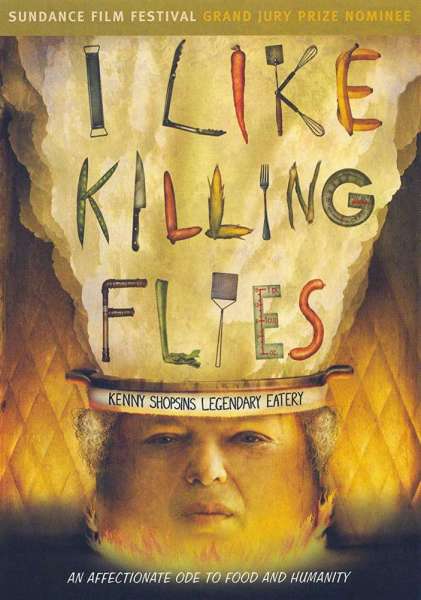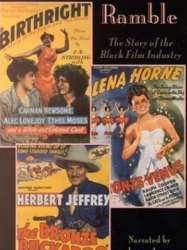I Like Killing Flies is a film of genre Documentary released in USA on 1 january 2004
I Like Killing Flies (2004)

If you like this film, let us know!
- Infos
- Casting
- Technical infos
- Photos
- Videos
- Film quotes
- Characters
- Music
- Awards
I Like Killing Flies is a 2004 documentary film produced, directed, filmed, and edited by Matt Mahurin. It documents Shopsins restaurant in New York City's Greenwich Village and its owner and head cook, Kenny Shopsin. In 2002 and 2003, Mahurin followed Shopsin in his final year at the location he ran for over 30 years. Throughout the film, Shopsin offers what he calls "half-baked" philosophy, peppered with profanities.
In the first half, Shopsin opens his eatery for the day and talks about his kitchen, his business, his employees, and his customers. We meet the regulars and friends who eat some of the 900 eclectic dishes he prepares, and we learn the rules of the restaurant: all customers must eat, parties of five or more are unwelcome, and anyone who irritates the owner will be swiftly shown the door. Shopsin's wife and children, all of whom work at the restaurant, weigh in on what it's like to work for this eccentric and occasionally hot-tempered man.
In the film's second half, Shopsin loses his lease and is forced to move his establishment to a larger location on nearby Carmine Street. Family, friends, and customers all pitch in to help with the move. Everything must go, from hundreds of knick-knacks and supplies to an alarmingly rickety stove. The reopening is a resounding success. The epilogue grants the audience one last glimpse of Shopsin's life the following year, and it is revealed that Shopsin's wife has died, but he seems not to have changed at all.
Shopsin, who has been profiled in The New Yorker by Calvin Trillin, wrote a 2008 book with Carolynn Carreño entitled Eat Me: The Food and Philosophy of Kenny Shopsin.
Comments
Leave comment :
Suggestions of similar film to I Like Killing Flies
There are 8969 with the same cinematographic genres, 997 films with the same themes (including 54 films with the same 2 themes than I Like Killing Flies), to have finally 70 suggestions of similar films.If you liked I Like Killing Flies, you will probably like those similar films :

Hollywood (1980)
Directed by Kevin Brownlow
Origin United-kingdom
Genres Documentary
Themes Documentary films about business, Documentary films about the film industry, Documentary films about cities
Actors James Mason
Rating92%





The series consists of thirteen fifty-minute episodes, with each episode dealing with a specific aspect of Hollywood history. The actor James Mason, an enthusiast of the period, supplied the narration; a lilting score was contributed by Carl Davis.
 , 2h13
, 2h13Directed by Gene Kelly
Origin USA
Genres Documentary, Musical
Themes Films about films, Films about music and musicians, Documentary films about business, Documentary films about the film industry, Documentary films about cities, Musical films, Documentary films about films
Actors Fred Astaire, Gene Kelly, Bud Abbott, Lou Costello, Lew Ayres, Stan Laurel
Rating72%





Gene Kelly et Fred Astaire présentent les meilleurs moments des films de la MGM.
 , 1h30
, 1h30Origin USA
Genres Drama, Documentary
Themes Documentary films about business, Documentary films about cities
Actors Sally Kellerman, Martin Landau, Ed McMahon, Margaret O'Brien, Suzanne Pleshette, Don Rickles
Rating67%






Casting By (2012)
, 1h29Origin USA
Genres Documentary
Themes Documentary films about business, Documentary films about the film industry, Documentary films about cities
Actors Marion Dougherty, Lynn Stalmaster, Woody Allen, Jeff Bridges, Glenn Close, Robert De Niro
Rating75%





The film is a celebration of the casting profession, highlighting its previously unsung role in film history while also serving as an elegy to the lost era of the New Hollywood. It focuses on casting pioneer Marion Dougherty, an iconoclast whose exquisite taste, tenacity and gut instincts brought a new kind of actor to the screen that would mark the end of the old studio system and help to usher in this revolutionary new period. The film draws a line through the last half century to show us the profession’s evolution from studio system type-casting to the rise of large ensemble films populated with unique and diverse casts.

The Celluloid Closet (1996)
, 1h47Directed by Rob Epstein, Jeffrey Friedman
Origin USA
Genres Drama, Documentary, Historical
Themes Films about films, Films about sexuality, Bisexuality-related films, LGBT-related films, Documentary films about business, Documentary films about the film industry, Documentaire sur l'homosexualité, Documentary films about cities, LGBT-related films, LGBT-related film
Actors Susan Sarandon, Lily Tomlin, Armistead Maupin, Arthur Laurents, Antonio Fargas, Tom Hanks
Rating77%





Le film montre comment le cinéma hollywoodien a évoqué le thème de l’homosexualité, comment cette représentation a évolué au fil des ans et comment, en retour, elle a influencé la perception de l’homosexualité par le grand public.

Midnight Ramble (1994)
, 1hOrigin USA
Genres Documentary
Themes Documentary films about business, Documentary films about the film industry, Documentary films about cities
Actors James Avery, Herb Jeffries, Toni Cade Bambara
Rating13%





The documentary begins with an explanation of the social context for American blacks at the turn of the 20th century. It then looks at milestones in the development of race films. This includes a look at early silent films, most notably the work of William Foster (The Pullman Porter, 1910).

The Cruise (1998)
, 1h16Directed by Bennett Miller
Origin USA
Genres Documentary
Themes Films about television, Documentary films about business, Documentary films about the film industry, Documentaire sur une personnalité, Documentary films about cities
Rating75%






Hollywood Without Make-Up (1963)
Directed by Ken Murray
Origin USA
Genres Documentary
Themes Documentary films about business, Documentary films about the film industry, Documentary films about cities
Actors Kirk Douglas, Ken Murray, Cary Grant, June Allyson, George K. Arthur, Eddie Albert
Rating71%





The film consists of archive footage of famous Hollywood stars, mostly home movies showing the stars as themselves instead of playing a role in front of the camera.

My Big Break (2009)
Directed by Tony Zierra
Origin USA
Genres Documentary
Themes Films about television, Documentary films about business, Documentary films about the film industry, Documentaire sur une personnalité, Documentary films about cities
Actors Wes Bentley, Brad Rowe, Chad Lindberg, Greg Fawcett, Tony Zierra
Rating75%





Filmed over ten years, this controversial documentary follows five roommates trying to make it in Hollywood who face the unexpected consequences of fame.

Sound City (2013)
, 1h48Directed by Dave Grohl
Origin USA
Genres Documentary, Musical
Themes Films about music and musicians, Documentary films about business, Documentary films about music and musicians, Documentaire sur une personnalité, Documentary films about cities, Musical films
Actors Trent Reznor, Dave Grohl, Barry Manilow, Rick Rubin, Rick Springfield, Lee Ving
Rating77%





Sound City Studios was located in the San Fernando Valley, amidst rows of dilapidated warehouses. The little-known recording studio housed a unique analog Neve recording console and a reputation for recording drums. Artists such as Red Hot Chili Peppers, Fleetwood Mac, Neil Young, Rick Springfield, Tom Petty, Kyuss, Slipknot and Nirvana recorded groundbreaking music at the studio. The film tells the story of the studio from its early days in 1969 until its closing in 2011. It then follows Dave Grohl's purchase of the studio's custom analog Neve console, which he moved to his personal studio, Studio 606. Rupert Neve is an English engineer who founded Neve Electronics in 1961, designed and manufactured the Neve 8028, "one of four in the world", and is interviewed by Grohl in the film. Famous musicians who recorded at Sound City reunite at Studio 606 for a jam session and to make an album of "all-new all-original songs, each one composed and recorded exclusively for the film within its own 24-hour session on that console." It also shows album covers by some bands: Red Hot Chili Peppers's One Hot Minute, Nirvana's Incesticide and Nevermind, Rage Against The Machine's self-titled album and many others.
 Connection
Connection